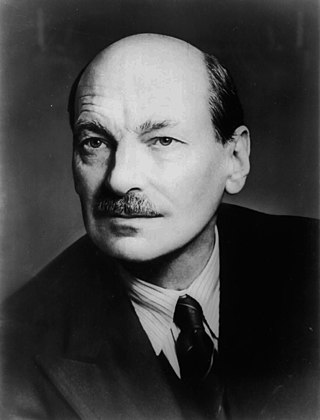
Clement Richard Attlee, 1st Earl Attlee, was a British statesman who was Prime Minister of the United Kingdom from 1945 to 1951 and Leader of the Labour Party from 1935 to 1955. Attlee was Deputy Prime Minister during the wartime coalition government under Winston Churchill, and Leader of the Opposition on three occasions: from 1935 to 1940, briefly in 1945 and from 1951 to 1955. He remains the longest serving Labour leader.

Francis Aungier Pakenham, 7th Earl of Longford,, known to his family as Frank Longford and styled Lord Pakenham from 1945 to 1961, was a British politician and social reformer. A member of the Labour Party, he was one of its longest-serving politicians. He held cabinet positions on several occasions between 1947 and 1968. Longford was politically active until his death in 2001. A member of an old, landed Anglo-Irish family, the Pakenhams, he was one of the few aristocratic hereditary peers ever to serve in a senior capacity within a Labour government.

Edward Arthur Alexander Shackleton, Baron Shackleton, was a British geographer, Royal Air Force officer and Labour Party politician.

Earl Attlee is a title in the Peerage of the United Kingdom. It was created on 16 December 1955 for Clement Attlee, the former Labour prime minister. At the same time he was made Viscount Prestwood, of Walthamstow in the County of Essex, which serves as the subsidiary title to the earldom and is also in the Peerage of the United Kingdom.

The 1955 United Kingdom general election was held on Thursday 26 May 1955, four years after the previous general election in 1951. It was a snap election: after Winston Churchill retired in April 1955, Anthony Eden took over and immediately called the election in order to gain a mandate for his government. It resulted in a majority of 60 seats for the government; the result remains the largest party share of the vote at a post-war general election. This was the first general election to be held during the reign of Elizabeth II. She had succeeded her father George VI the year after the previous election.

Christopher Addison, 1st Viscount Addison,, was a British medical doctor and politician. A member of the Liberal and Labour parties, he served as Minister of Munitions during the First World War and was later Minister of Health under David Lloyd George and Leader of the House of Lords under Clement Attlee.

Albert Victor Alexander, 1st Earl Alexander of Hillsborough, was a British Labour and Co-operative politician. He was three times First Lord of the Admiralty, including during the Second World War, and then Minister of Defence under Clement Attlee.

William Allen Jowitt, 1st Earl Jowitt, was a British Liberal Party, National Labour and then Labour Party politician and lawyer who served as Lord Chancellor under Clement Attlee from 1945 to 1951.
Geoffrey Henry Cecil Bing CMG QC was a British barrister and politician who served as the Labour Member of Parliament for Hornchurch from 1945 to 1955. He was also Attorney General of Ghana.
The 1955 Labour Party leadership election was held following the resignation of Clement Attlee. Attlee was Prime Minister from 1945 to 1951 and stayed on as party leader until he lost the 1955 general election.

Arthur Moyle, Baron Moyle, CBE was a British bricklayer, trade union official and politician. As a member of parliament for nineteen years, he was principally known for serving as Parliamentary Private Secretary to Clement Attlee during Attlee's Premiership. He was also perennially lucky in the ballot for Private Member's Bills.

Laurence Norman Helsby, Baron Helsby was a British civil servant.

Herbert Stanley Morrison, Baron Morrison of Lambeth, was a British politician who held a variety of senior positions in the Cabinet as a member of the Labour Party. During the inter-war period, he was Minister of Transport during the Second MacDonald ministry, then after losing his parliamentary seat in the 1931 general election, he became Leader of the London County Council in the 1930s. After returning to the Commons, he was defeated by Clement Attlee in the 1935 Labour Party leadership election but later acted as Home Secretary in the wartime coalition.
Sir David Bruce Pitblado KCB CVO was a principal private secretary to the office of the Prime Minister of the United Kingdom. Serving from 1951 to 1956, he was associated with Prime Ministers Clement Attlee, Winston Churchill, and Anthony Eden. With his colleague Jock Colville, he was one of Churchill's last two principal private secretaries at 10 Downing Street.

The statue of Clement Attlee on the Mile End campus of Queen Mary University of London is a bronze sculpture of the British Prime Minister, created by Frank Forster in 1988. The statue was commissioned by the Greater London Council and was intended to stand in Mile End Park. By the time of its completion in 1988, the GLC had been abolished and the statue was offered to any successor authority willing to pay the relocation costs. These were met by Tower Hamlets London Borough Council and the statue was erected outside the Limehouse Public Library to commemorate Attlee's role as the member for the Limehouse parliamentary constituency. The opening ceremony was carried out by Harold Wilson, the last living member of Attlee's 1945-51 administration. By the 21st century, the statue had been badly vandalised and was boarded up. In 2010, Tower Hamlets Council offered the statue to Queen Mary University of London on permanent loan. It was re-erected on a site at the Mile End Road campus, next to the People's Palace where Attlee had attended the vote counting in the 1945 general election and learnt of the victory which brought in his peace-time government.

Sir Denis Hubert Fletcher Rickett,, was a British civil servant who served as Clement Attlee's Principal Private Secretary (PPS) from 1950 to 1951 and as vice-president of the World Bank from 1968 until 1974.















